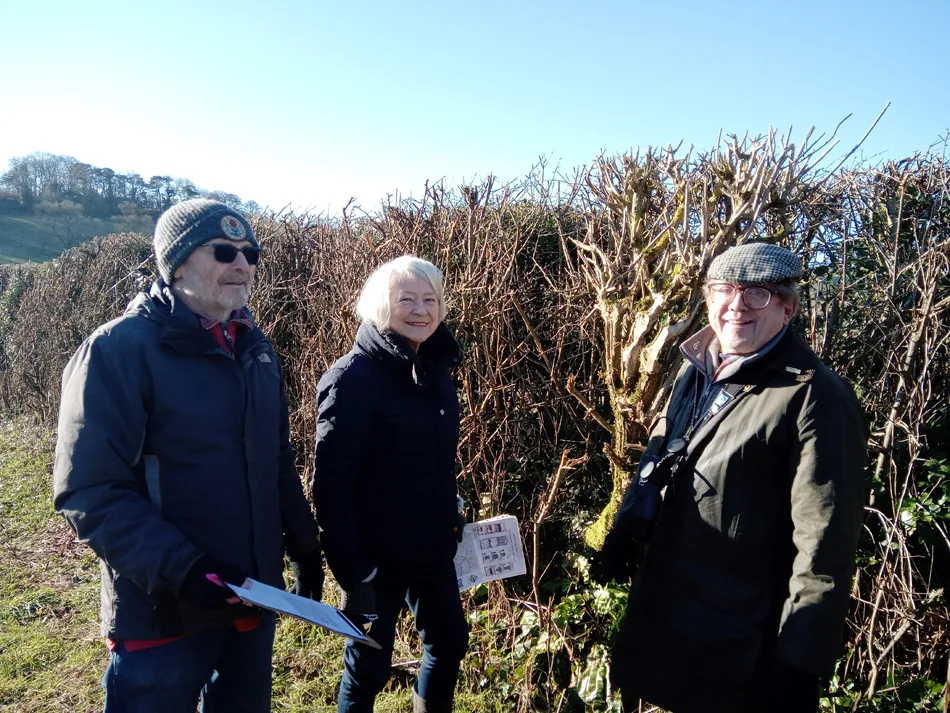Across Dorset, farmers and volunteers are joining forces – Rupert Hardy finds out how the Great Big Dorset Hedge is quietly reshaping our rural landscape

Dorset CPRE’s 88th AGM will be held on 15th November at Cerne Abbas Village Hall, where guest speaker and Charmouth farmer John Calder will talk about a project that’s quietly transforming Dorset’s countryside. Since 2022, the Great Big Dorset Hedge – partly funded by Dorset CPRE – has been restoring and extending the county’s hedgerows.
Often overlooked, the humble hedge is a vital refuge for wildlife: a larder, shelter and corridor for birds, mammals and insects. It’s the farmed landscape’s unfarmed edge – one that stores carbon, slows water and softens field boundaries. Hedges escape the intensification of modern farming.

The Great Big Dorset Hedge
‘The aim,’ says John Calder, ‘is to bring landowners, volunteers and local communities together to enhance and extend Dorset’s hedgerows over time.’
So far, more than 100 farmers have signed up to have the GBDH volunteers survey all the hedges on their farms: and the project now involves planting, too. More than 400 volunteers have enlisted and over 500 km of hedges have been surveyed, all over Dorset.
Surveys are carried out in summer when hedges are in full leaf – winter is for planting.
The project has received widespread praise from organisations like Dorset National Landscape and the Farming & Wildlife Advisory Group, with Clare Lees of Post Green Farm noting that it helps ‘bridge the gap between urban and rural communities.’
Though there have been challenges, including the sudden abandonment of the Sustainable Farming Incentive scheme, John remains optimistic. “When new funding arrives next spring, hedgerows will stay central to the agenda,” he says. Later this year, he expects Dorset’s Local Nature Recovery Strategy to prioritise hedgerows as a stand-alone target, with GBDH highlighted as an example of nature recovery in action.
Within the GBDH project, new collaborations are emerging all the time. Since the middle of 2025, Wessex Water has been introducing the team to farmers in the Poole Harbour catchment area (which covers much of the southern half of the county) so that enhanced and increased hedgerows are created where they have the most impact on water quality. In early 2026, John expects a comprehensive assessment of every hedge in the Brit Valley Landscape Recovery Project, which covers 600km of hedgerows across 50 neighbouring farms.

Farmers in the project
From small family-run farms to larger estates, farmers across Dorset have signed up to the project. At Post Green Farm in Lytchett Minster, volunteers have surveyed 40km of hedgerows, and last winter they began replanting. Similarly, at Rampisham Farm in West Dorset, 50km of hedges have been surveyed, with 30km at Bussey Stool Farm and 20km at Lower Farm. All four farms have contributed financially to the project.
George Hosford, Dorset CPRE’s agricultural adviser and former chair of NFU Dorset (and, of course, regular BV columnist), says the results have been remarkable: ‘I’m bowled over by the success of the GBDH project.’
A solid base of farmers and volunteers has now been established, and specialist contractors are being used to orchestrate the volunteers.
However, John has a message for farmers north of Dorchester, where the take up has been less enthusiastic than elsewhere: ‘Please do invite the GBDH volunteers onto your farm now!’

Dorset hedgelaying competition
Dorset CPRE is also one of the sponsors of an annual Dorset Hedgelaying Competition held in September, organised by the Melplash Agricultural Society, which is committed to keeping the traditional skill of hedge laying. This year’s event, hosted by kind permission of JH Yeates & Son and Mr Colin Hawkins, was at Toller Fratrum in West Dorset under bright autumn sun. Competitors were given six hours to lay 10 metres of hazel hedge in the Dorset Style – laid on top of a bank, tightly woven with itself, and bonds (thin sticks) are used to secure it internally and externally. The finished hedge should be curved like a half-barrel and around 3′ high.
The event welcomes spectators and is free to attend, so do go along next year to learn more. There are classes for individuals and pairs, open to both novices and experienced hedgelayers, and there is also a mechanical flail hedge cutting class.
Judging was carried out by local experts, including Roger Vickery from Thorncombe and Kevin Goodfellow from Bridport, Phil Hart from Uckfield, Chris Stanton from Ashburton and Peter Yeates from Bridport.
If you would like to get involved with the GBDH as a volunteer, please sign up at https://tinyurl.com/VolunteerGBD


